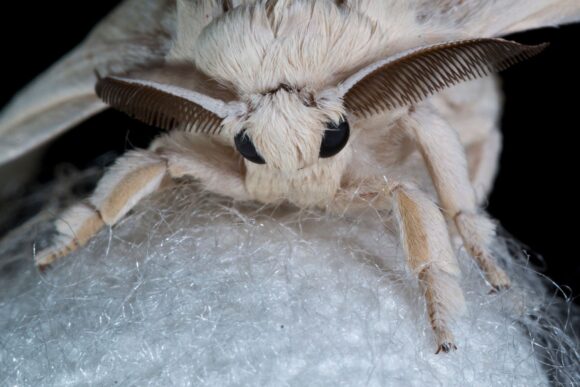In 1766, two years after his arrival in Buenos Aires, Father Ramon Maria Termeyer, Society of Jesuits, wandered on horseback through a carob forest and into a maze of spiders’ webs so strong, “they got in the way of me and my horse and made my hat fall from my head, unless I took care to break them with a rod.” Glancing around, he realised with a thrill that he was surrounded by cocoons quite as large as the spiders watching him from every branch; and it was a thrill, one might add, not of horror, but of mercantile possibility: what if these spiders could be forcibly silked?
Indeed they could: one of the stranger pictures in this strangest of histories is a contemporary diagram of a 1900 machine made to “milk” related Golden Orb spiders in Madagascar.
Readers coming to this globe-trotting and species-leaping volume expecting vignette after genteel vignette of 5000-odd years of Chinese silk manufacture are in for a very nasty shock indeed. Here be spiders, and not just spiders, but metre-long Mediterranean clams, never mind countless moth species spinning their silks everywhere from Singapore to Suriname. As the entomologist Rene-Antoine Ferchault de Réaumur observed in 1711, “nature does not limit itself to a few examples, even of its most singular productions.”
This sets Aarathi Prasad quite a challenge: billed as “a cultural and biological history”, Silk must flit from China, Indonesia and India to South America and Madagascar, and from there to the Mediterranean to examine Procopius of Caesarea’s “cloak made of wool, not such as produced by sheep, but gathered from the sea”.
The Chinese silkworm, Bombyx mori, necessarily holds centre stage, since it has played a leading role in our understanding of the natural world. The 17th-century naturalist and globetrotter Maria Sybilla Merian traced its lifecycle to scotch the idea that small organisms arose spontaneously out of decomposing matter. In 1807 the Italian Agostino Bassi showed how infection was transmitted from a sick caterpillar to a healthy one, in a paper that Louis Pasteur read 60 years later, as he formulated the germ theory of disease.
Then there’s the author’s own experience of these strange creatures, “cute but not beautiful”, and unable, in their adult form, to eat or defecate — “nor do they do much at all as moths, except to mate and die.” As a child Prasad used to feed her larvae with mulberry leaf paste, then watched as they span “cradles of their own making, swaddled in kilometres of pure white silk.”
Chinese silk domestication, which began around the Yellow River, sometime in the Neolithic period, between 7500 and 5,000 years ago, bequeathed us helpless, flightless grubs that require human intervention just to survive. Other domestication strategies were followed in India, where Antheraea paphia, still winged, still brightly coloured, spins extravagant cocoons of rough, rugged, golden tasar silk and hangs them on a “stalk” from its favourite trees. Roman writers, seeing their branches so thickly festooned, thought these silk farmers were harvesting fruit.
Weaving between these natural wonders are the human stories; of Marcello Malpighi, whose dissection of Bombyx mori for the Royal Society in the 1660s took an entire year; of Georg Eberhardt Rumpf, whose survey of cocoon-producing moths in Indonesia triggered a quite surreal string of personal disasters; of Thomas Wardle, whose Midlands factory hands finally worked out out how to bleach and print on tasar silk, triggering a boom in India’s silk exports.
The effort to personalise and dramatise such a wealth of unfamiliar and often downright peculiar information sometimes empurples Prasad’s prose, as when, “with her luggage ready, her younger child and a magnifying glass close at hand, Merian departed over the slick, white-capped waves of Amsterdam’s harbour on that busy seaway out of the Dutch Republic: first to the wind-bound sea channels of the island of Texel, past the Isle of Wight, the storm-worn point of Portland from whose glowing stones London’s St Paul’s Cathedral was still being built, and out of the English Channel into the treacherous, sloping swells of the Bay of Biscay.”
But flourishes like these have their charm, and did after all gift us Termeyer’s spooky, unforgettable ride among the webs of Aranea latro.
Those readers less enamoured of Prasad’s bravura scene-setting will discover more sardonic pleasures. The Austrian archduke Franz Ferdinand, it seems, owned quite the latest in personal body protection: a bullet-proof vest made of silk. On 28 June 1914 he forgot to put it on.
Scientific accounts of silk traditionally end in Arthur C Clarke territory, rather breathlessly describing how Earth-tethered space elevators made of synthetic silk will propel future astronauts into orbit. Prasad’s not holding her breath over that one, though she does treat us to a futuristic vision of “flexible and biodegradable implantable electronics that record our brain signals” and “edible sensors we could safely consume to track our fitness or the nutritional quality of our food”.
Mostly though Prasad is happy to admit that “more often, scientific progress is just tiresomely incremental.” Technological wonders will follow our continuing investigations, but they will do so in their own good time. One especially gratifying lesson to be drawn from this charming and absorbing book, is that silks will sustain their mystery and surprise and glamour for a while yet.

